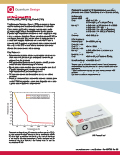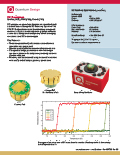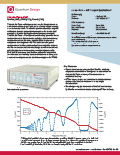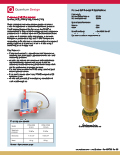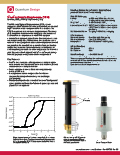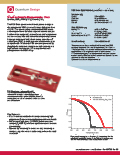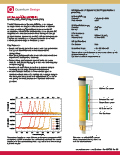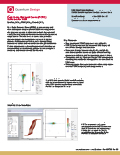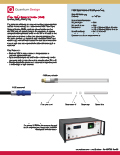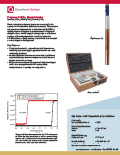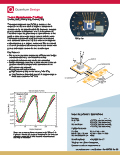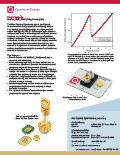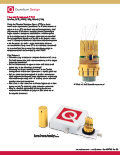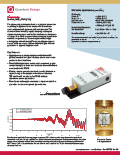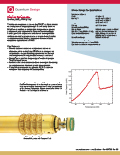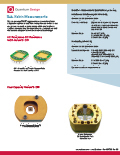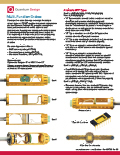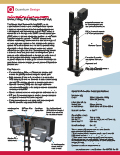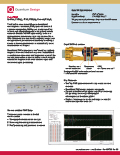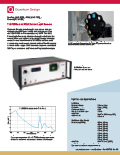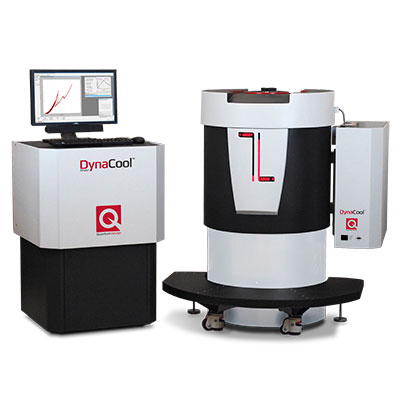
Physical Property Measurement System
Quantum Design PPMS® DynaCool®
The popular Physical Property Measurement System (PPMS) from Quantum Design is now available in a truly cryogen-free package. The PPMS DynaCool uses a single two-stage Pulse Tube cooler to cool both the superconducting magnet and the temperature control system, providing a low vibration environment for sample measurements. It offers continuous low temperature control and precise field and temperature sweep modes.
The PPMS DynaCool also comes standard with an integrated cryopump, which makes it compatible with all available PPMS measurement options, or any other user-designed experiments, right out of the box!
Features
- No need for liquid cryogens
- Temperature range of 1.8 K – 400 K
- 9 T, 12 T and 14 T magnets available
- Continuous Low-Temperature Control – maintains temperatures below 4.2 K with smooth temperature transitions when warming and cooling through 4.2 K
- Controlled temperature Sweep Mode
- Fully automated operation of available PPMS measurement options
- Built-in Cryopump for high vacuum applications (<10-4 Torr)
- New electronics built using CAN architecture for improved reliability
- Standby mode conserves power while requiring only a short recovery time
Available Measurement Options
PPMS Options Compatibility Table
AC Resistance (ETO)
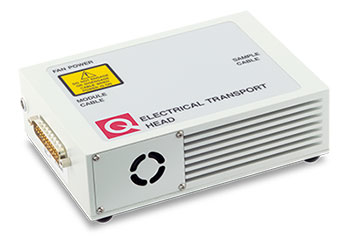
The Electrical Transport Option (ETO) enables AC resistance measurements of samples using a 4-probe lead configuration. For samples with higher resistances, a 2-probe high impedance mode is also available. Signals from two channels can be collected simultaneously.
- Measure resistances of 10 μΩ – 10 MΩ in a standard 4-probe configuration
- Resistances of 2 MΩ – 5 GΩ can be measured in the high-impedance 2-probe configuration
- Automated I-V curve collection can be used to screen for ohmic contacts
DC Resistance
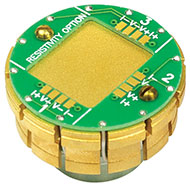
DC resistance on up to three channels using a standard puck can be measured using the DC Resistivity Option.
- Measure resistances of 10 μΩ – 5 MΩ in a standard 4-probe configuration
- Source currents between 2 nA – 8 mA
- Configurable bridge parameters to limit the voltage, current, or power at the sample for protecting sensitive devices, films, etc.
van der Pauw – Hall Transport
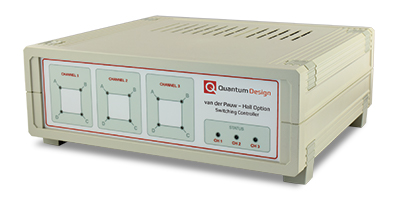
Improved accuracy in both resistivity and Hall coefficient measurements is possible using the van der Pauw technique. This Option utilizes a switching controller to automatically collect data necessary to accurately calculate parameters such as carrier concentration and sheet resistance for a uniformly thick sample of arbitrary shape.
- Configurable MultiVu sequence commands automatically source current and measure voltage for a series of lead permutations, in either the standard van der Pauw or Hall geometries
- An integrated IV-Curve utility allows the user to confirm Ohmic nature of contacts as needed during a measurement
MeasureReady® M91 FastHall™
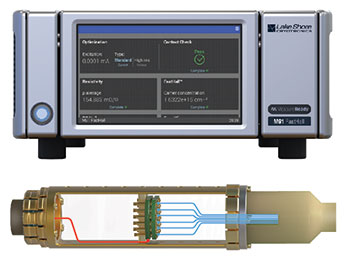
The M91 FastHall Controller supports both van der Pauw (4 connections) and Hall bar (6 connections) geometries. In the standard resistance model, these samples are wired to Quantum Design’s PPMS sample puck. The high resistance M91 HR model provides a larger resistance range than the standard model. The high resistance version comes equipped with a custom Lake Shore Hall insert to be used within your PPMS. The insert is fully-guarded from instrument to sample for ultra-low noise measurements.
- Supports van der Pauw and Hall bar samples
- Standard resistance M91 range: 10 mΩ to 10 MΩ
- High resistance M91 HR range: 10 mΩ to 10 GΩ
- Cut measurement time up to one half with no field reversal needed
- Switching technique minimizes thermal drift
MeasureReady® M81-SSM

M81-SSM

M81-SSM Breakout Box
The Lake Shore MeasureReady M81-SSM (Synchronous Source and Measure) system provides a straightforward approach for advanced measurement applications. The M81-SSM is designed to eliminate the complexity of multiple function-specific instrumentation setups, combining the convenience of DC and AC sourcing with DC and AC measurement, including a lock-in's sensitivity and measurement performance. Highly adaptable for a range of material and device research applications, the extremely low-noise system ensures synchronized measurements from 1 to 3 source channels and from 1 to 3 measure channels.
- Simultaneous source module update and measure module sampling timing across all channels
- DC/AC amplitude and phase detection are user-selectable on all measure channels
- Linear module power supply architecture for lowest possible source/measure noise
- All source and measure channels are capable of DC and AC to 100 kHz signals
- Optimized for fundamental, harmonic, and phase AC plus DC biased measurements
- Source and measure module options currently include:
- VM-10 voltage measure, CM-10 current measure, VS-10 voltage source, and BCS-10 balanced current source module
- Lake Shore breakout box (pictured right) and MeasureLINK application pack ensure connectivity to the PPMS base system
Horizontal Rotator
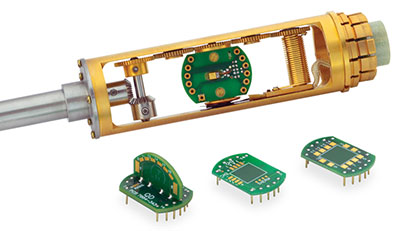
The Horizontal Rotator enables a transport sample to be rotated over a full 360° in the presence of an applied magnetic field. An automated indexing procedure and encoder ensures accurate angular positions and the on-board thermometer monitors the temperature in close proximity to the sample.
- Rotate a sample between -10° – 370° to change the orientation of the applied magnetic field relative to the installed sample
- Motor available in Standard Resolution (0.0133°/step) and High Resolution (0.0011°/step) versions
Pressure Cell (Transport)
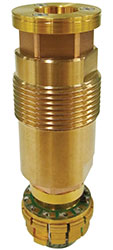
The Transport Pressure Cell Option for the PPMS is manufactured by ElectroLab, a leading Japanese supplier of pressure cells. It enables up to two 4-probe measurements (typically for the sample and a manometer) of electrical transport at pressures as high as 2.7 GPa.
- Includes manometer materials of tin and lead
- Data can be collected with any PPMS-compatible QD transport option
Vibrating Sample Magnetometer (VSM)
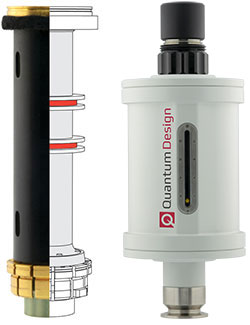
The VSM enables measurement of a sample's magnetic moment as a function of temperature or magnetic field. Magnetic phase transitions and hysteretic behavior are quickly resolved with typical acquisition times for a single datum around 1 second.
- Noise levels of less than 6·10-7 emu at 300 K are achieved using a lock-in measurement technique to isolate the sample signal from external mechanical and electronic noise
- A temperature sensor integrated within the coil set provides local sample thermometry via exchange gas coupling
- The optional Large Bore Coil Set enables an even wider variety of sample holders with minimal loss of sensitivity
VSM Oven
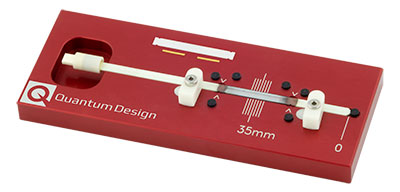
The VSM Oven allows for conventional VSM measurements in the temperature range of 300 – 1000 K. A special alumina sample holder with an integrated resistive heater and temperature sensor locally heat and sense the sample temperature.
- User kit comes standard with high temperature Zircar cement and copper radiation shields for sample mounting
- Noise levels are less than 6·10-6 emu at 300 K
AC Susceptibility (ACMS II)

The AC Measurement System (ACMS II) utilizes a mutual induction-based technique to determine a sample's dynamic (AC) susceptibility. The system also enables the user to perform DC magnetization measurements without any changes to the hardware configuration for unparalleled convenience.
- AC moment sensitivity of 1·10-8 emu is achieved by a multi-point automated nulling procedure to minimize the contribution of background signal
- AC excitation fields of 0.05 – 15 Oe are available at frequencies from 10 Hz – 10 kHz
- Automated touch-down procedure preserves sample centering across large changes in temperature
First Order Reversal Curve (FORC) Software for VSM
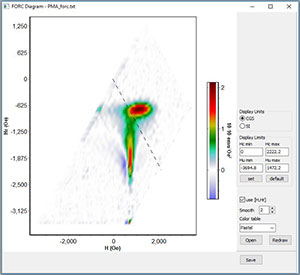
First Order Reversal Curve (FORC) measurements and their subsequent analysis provide additional insights into the magnetic reversal mechanisms of samples that conventional major hysteresis loops cannot. The families of curves generated can reveal signatures of particular magnetic reversal mechanisms.
- Compatible with any Quantum Design VSM configuration
- FORC distributions can be displayed in real-time during a measurement
Fiber Optic Sample Holder (FOSH) for VSM

The VSM Fiber Optic Sample Holder (FOSH) enables light to be delivered to the VSM sample space during a measurement.
- Specialized sample rod and holder transmits a wide spectrum of light
- Standardized fiber connection ensures compatibility with a variety of light sources
Pressure Cell (Magnetometry)
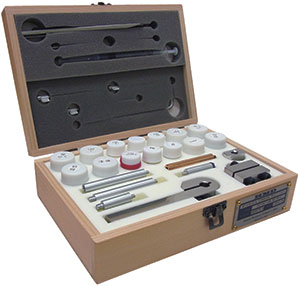

The pressure cell option for magnetometry is manufactured by HMD, a leading Japanese supplier of pressure cells. A simplified design requires neither copper sealing rings or a hydraulic press to achieve the maximum available pressure of 1.3 GPa.
- Included manometer materials are tin and lead
- BeCu construction affords a minimal, uniform magnetic background
Torque Magnetometry
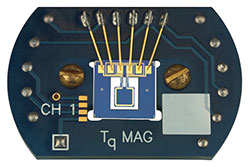
The torque magnetometer measures a sample's magnetic moment through the application of a static magnetic field to generate a torque on a small cantilever. The torsion is measured using piezoresistive elements to study the moment as a function of magnetic field strength, temperature, or angular orientation with respect to the field.
- Noise levels in the measured torque are 1·10-9 N·m (high sensitivity cantilever)
- Integrated calibration loop on the cantilever chip
Heat Capacity
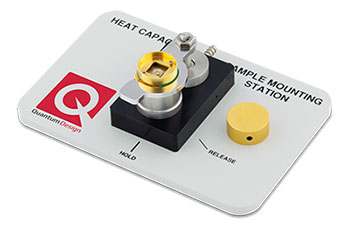

High-precision microcalorimetry experiments can be performed using the Heat Capacity option to measure a sample's heat capacity as a function of temperature. Measurements in a static applied magnetic field are also possible using the automated field calibration function of the software.
- Typical addenda signal of 0.2 μJ/K at 2 K, where signal resolution is 2 nJ/K
- Software automates the collection of addenda (background) signal and performs the necessary subtraction for determining the sample's heat capacity
- Integrated data post-processing tools enable high-resolution sampling of sharp first-order transitions
Thermal Transport Option (TTO)
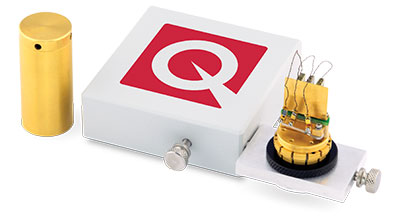
Thermoelectric materials can be rapidly characterized using the TTO to simultaneously measure a sample's thermal conductivity, Seebeck coefficient, and electrical resistivity. A continuous data acquisition mode allows for higher density curves to be collected in less time to increase throughput for a typically time-consuming measurement.
- The thermoelectric figure of merit ZT is automatically calculated for fast and convenient data evaluation
- Included sample mounting supplies allow for a wide variety of materials to be measured
Dilatometer

Subtle changes in a sample's lattice expansion/contraction due to changes in temperature or magnetic field are readily characterized using the dilatometer option. An innovative fused-silica construction drastically minimizes background signals compared with traditional copper-cell setups, and no costly absolute capacitance bridge is required.
- Sample dilation signals less than 10 pm can be resolved (at 2 K)
- Bulk coefficients of thermal expansion of magnetostriction are automatically calculated and reported
- High purity copper sample and reference data provided
Publications
Dilution Refrigerator
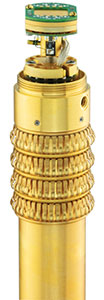
The Dilution Refrigerator option allows access to a temperature range of 4 K – 50 mK, the lowest temperature attainable in a PPMS. Seamless integration means temperature control is just as simple as in the base PPMS, with all gas handling and manifold operations automatically controlled by the MultiVu software.
- Base temperature (50 mK) is typically achieved in about 5 hours when cooling from room temperature
- Closed cycle system ensures the valuable 3He/4He gas mixture is not lost in normal operation
- Compatible measurement options include AC Susceptibility, Heat Capacity, and Electrical Transport
Helium-3 Refrigerator
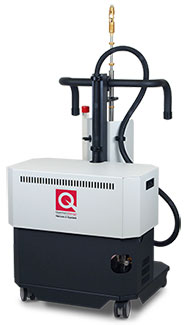
A range of nearly four decades in temperature (350 K – 0.4 K) is accessible with the Helium-3 Refrigerator. Seamless integration means temperature control is just as simple as in the base PPMS, with all gas handling and manifold operations automatically controlled by the MultiVu software.
- Base temperature (0.4 K) is typically achieved in about 2 hours when cooling from room temperature
- Closed cycle system ensures the valuable 3He gas is not lost in normal operation
- Compatible measurement options include Heat Capacity, and Electrical Transport
Adiabatic Demagnetization Refrigerator (ADR)

The minimum achievable temperature (at zero field) in the PPMS is readily extended down to 100 mK with the ADR. Using the PPMS magnet to leverage the magnetocaloric effect in paramagnetic salt cools samples to 100 mK, and electrical transport properties can be measured as the temperature drifts back up to the nominal PPMS base.
- Base temperature (100 mK) is typically achieved in about 3 hours when cooling from room temperature
- Uncontrolled drift up to 1.9 K typically lasts about 2 hours
- Compatible with all electrical transport options
Sub-Kelvin Measurements
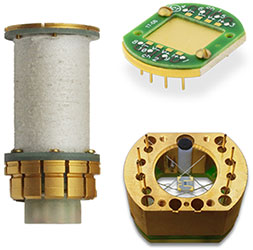
Several measurement options have been adapted to work in sub-Kelvin environments, extending the range across which certain properties can be measured:
- Electrical Transport (ETO/Resistivity): Available for ADR, Helium-3, DR
- Heat Capacity: Available for Helium-3, DR
- AC Susceptibility: Available for DR
Publication
Multi-Function Probes
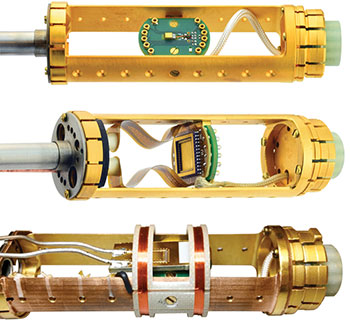
For advanced users looking to build custom experiments inside the PPMS, QD's MFPs provide an interface with the integrated chamber wiring and also simplify the process of bringing external connections (electrical, optical, etc.) in from the top of the probe. A number of variants are available:
- Types A, B, and M provide different socket configurations for electrical access
- Type C only includes the probe with baffles and no electrical interface
- Photoconductivity Variant includes an integrated fiber feedthrough
- CryoFMR Variant works with the NanOsc CryoFMR Spectrometer
Optical Multi-Function Probe (OMFP)
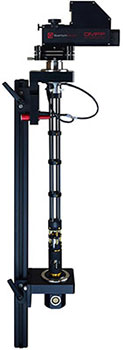
Optical access to the sample chamber of the PPMS is readily attained using the OMFP. An integrated camera imaging system and pizeo-positioner capsule make identifying and navigating to a region of interest on the sample straightforward.
- Camera can resolve features less than 5 μm in size
- Positioning capsule allows for movement in the x, y, and z axes with a full range of 3 mm in each direction
- Two four-probe channels available for correlating optical data with electrical transport measurements
NanOsc FMR Spectrometers

Broadband FMR spectroscopy allows for measurements continuously spanning several 10's of GHz. Measurements over a wide frequency range allow for significant improvements in accurately extracting a variety of material parameters not accessible by static measurement techniques.
- Turn-key FMR spectrometer with easy to use software interface
- Calculates the effective magnetization (Meff), anisotropy (K), gyromagnetic ratio (γ), damping (α), and inhomogeneous broadening (ΔHO)
- Enables the user to extract the exchange stiffness (A) and inverse spin Hall effect ISHE
Optical Multi-Function Probe (OMFP)

Optical access to the sample chamber of the PPMS is readily attained using the OMFP. An integrated camera imaging system and pizeo-positioner capsule make identifying and navigating to a region of interest on the sample straightforward.
- Camera can resolve features less than 5 μm in size
- Positioning capsule allows for movement in the x, y, and z axes with a full range of 3 mm in each direction
- Two four-probe channels available for correlating optical data with electrical transport measurements
Light Sources
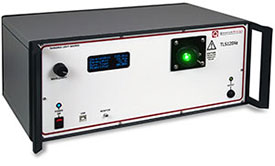
For experiments requiring illumination inside the PPMS sample space, two broadband xenon light sources are available:
- The TLX120Xe utilizes a 100 W source and integrates a motorized monochromator such that the light wavelength can be selected using a sequence command in MultiVu
- The MLS 300 W source includes a manual selection filter wheel for passing pre-determined wavelengths of light
Videos
TTO Webinar
The Ease of Switching PPMS Measurement Options
VSM Webinar




